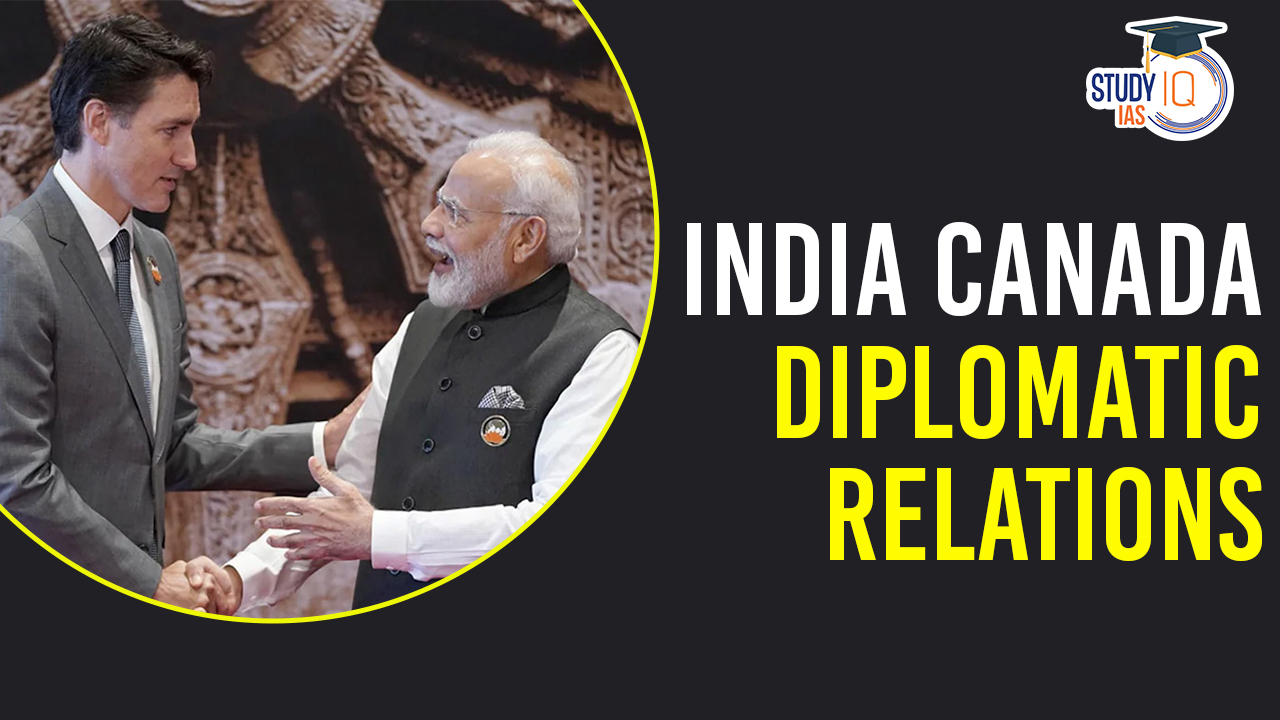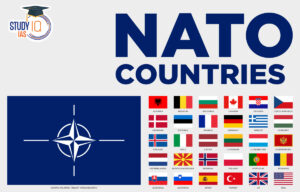Table of Contents
Context: Mark Carney’s rise as Canada’s new leader marks a shift from Justin Trudeau’s tenure, offering India a chance to reset diplomatic ties and strengthen trade, security, and strategic cooperation.
India-Canada Relations Evolution
|
Timeline |
|
| Year | Event |
| 1858 |
|
| 1914 |
|
| 1947 |
|
| 1954 | Canadian Prime Minister Louis St. Laurent visited India, the first Canadian Prime Minister to do so. |
| 1956 | India obtained the CIRUS (Canada-India Reactor, U.S.) research reactor from Canada which became operational in 1960. |
| 1974 | India conducted its first nuclear test known as “Smiling Buddha”. Canada suspended nuclear cooperation with India(1976). |
| 1984 | Operation Blue Star, was a military operation ordered by the Indian government to remove Sikh militants who were hiding in the Golden Temple in Amritsar. It was condemned by the Sikh diaspora in Canada and Canadian diplomats. |
| 1985 | Air India Flight 182, en route from Toronto to Delhi, is bombed mid-air off the coast of Ireland, killing all onboard. This terrorist act severely strains the relations between the two countries. |
| 1997 | India and Canada established the Canada-India Working Group on Counter-Terrorism. |
| 2009 | Canadian Prime Minister Stephen Harper visited India. |
| 2010 |
|
| 2015 | Canadian Prime Minister Justin Trudeau visited India. |
| 2018 | India and Canada signed a Comprehensive Strategic Partnership Agreement (CEPA). |
Background of India-Canada Relations
Diplomatic relations between India and Canada date back to 1947. A significant milestone in this relationship occurred in April 2015 when the Prime Minister of India visited Canada, elevating bilateral ties to a strategic partnership. In recent times, both nations have been actively collaborating to strengthen cooperation across various sectors of shared significance.
Early Diplomatic Ties (1947–1974)
- India and Canada established diplomatic relations in 1947, shortly after India’s independence.
- Canadian PM Louis St. Laurent visited India in 1954, strengthening bilateral ties.
- Relations were positive, focusing on development cooperation and Commonwealth ties.
Strain Over Nuclear Issues (1974–1998)
- Canada halted nuclear cooperation after India’s nuclear test in 1974 (Pokhran-I).
- Tensions increased further after India’s nuclear tests in 1998 (Pokhran-II).
Renewed Engagement (2000–2010)
- Relations improved with growing trade and investment ties.
- The India-Canada Nuclear Cooperation Agreement (2010) allowed uranium exports to India for civilian use.
Strengthening Strategic Ties (2010–2018)
- PM Stephen Harper (2012) and PM Narendra Modi (2015) visited each other’s countries.
- Bilateral trade and defence cooperation grew.
- Canada recognised India as a strategic partner in the Indo-Pacific region.
Challenges Under Trudeau (2018–2023)
- Tensions over Khalistani separatism affected diplomatic relations.
- The killing of Hardeep Singh Nijjar (2023) strained ties, leading to a diplomatic fallout.
India-Canada Bilateral Ties
Bilateral Mechanisms
Both countries engage in bilateral relations through various dialogue mechanisms, including ministerial-level dialogues such as Strategic, Trade, and Energy dialogues, Foreign Office Consultations, and sector-specific joint working groups (JWG).
Commercial Relations
India and Canada have been working to enhance their trade and economic relations. An annualized Trade Ministers dialogue was established to review economic ties, and negotiations for a Comprehensive Economic Partnership Agreement (CEPA) were ongoing, covering trade in goods, services, investment, and trade facilitation.
Nuclear Cooperation
While India and Canada faced a setback in their relations after India’s nuclear test in 1974, they signed a Nuclear Cooperation Agreement (NCA) in June 2010, which came into force in September 2013. A Joint Committee on Civil Nuclear Cooperation was formed as part of this agreement.
Science and Technology
Indo-Canadian Science and Technology collaboration primarily focuses on advancing Industrial R&D with the potential to generate new IPs, processes, prototypes, and products. An Action Plan for 2017-18 was jointly crafted, emphasizing cooperation in emerging fields like Artificial Intelligence, Nano-technology, and 3D printing.
The Department of Biotechnology, through the IC-IMPACTS program, conducts joint research ventures in healthcare, agri-biotech, and waste management. Additionally, the Department of Earth Science and Polar Canada has initiated a knowledge exchange program for scientific research in Cold Climate (Arctic) Studies. This bilateral effort aims to harness innovation and knowledge for mutual benefit.
Space
India and Canada have cooperated in the field of space since the 1990s, with collaboration in space science, earth observation, satellite launch services, and ground support for space missions. Memorandums of Understanding (MOUs) were signed in 1996 and 2003 between ISRO and the Canadian Space Agency.
Security and Defence
India and Canada collaborate in various international forums, including the UN, Commonwealth, and G-20. Defence ties have expanded with mutual ship visits and cooperation on counterterrorism issues, particularly through the Joint Working Group on Counter-Terrorism.
Agriculture
A bilateral MoU on agriculture cooperation was signed in 2009, leading to the creation of sub-groups on knowledge exchange in emerging technologies, animal development, agricultural marketing, and a separate Joint Working Group for Pulses.
Education
Education is a significant area of mutual interest, with India becoming the top source of foreign students studying in Canada. The MoU on Higher Education was renewed in February 2018.
People-to-People Ties
Canada hosts a substantial Indian diaspora, including Persons of Indian Origin (PIOs) and Non-Resident Indians (NRIs), constituting over 4% of its population. The Indian diaspora has made notable contributions to various sectors in Canada, including politics.
Cultural Exchanges
Canada was the Country of Focus at the 48th International Film Festival of India in 2017, and there is an India-Canada coproduction agreement in films. Diwali has been celebrated on Parliament Hill for several years.
Cooperation in COVID-19 Pandemic
During the COVID-19 pandemic, India and Canada collaborated on repatriation flights for Canadian nationals in India and the supply of essential medicines, including paracetamol and hydroxychloroquine.
Potential Improvements and Opportunities for India After Trudeau’s Exit
- Restoration of Diplomatic Ties: India can reappoint its High Commissioner to Canada, signalling a normalization of diplomatic relations.
- The removal of Trudeau, who was seen as influenced by Khalistani elements, opens the door for more pragmatic engagement.
- Trade and Economic Cooperation: The resumption of stalled Comprehensive Economic Partnership Agreement (CEPA) negotiations can boost bilateral trade.
- Canada’s focus on clean energy, agri-tech, and pharma presents new trade opportunities for India.
- India can leverage its growing market and skilled workforce to attract Canadian investments.
- Strategic and Security Collaboration: Both countries can deepen cooperation on Indo-Pacific security, maritime domain awareness, and counterterrorism.
- India and Canada share a common stance on ensuring a free and open Indo-Pacific, especially in light of China’s growing influence.
- Diaspora Engagement and Immigration: An improved political climate can strengthen the role of the Indian diaspora in Canada as a bridge for deeper ties.
- India can push for easier work and student visas to facilitate people-to-people exchanges.
- Energy and Climate Cooperation: India and Canada can collaborate on green energy transitions, including clean hydrogen and renewable energy.
- Shifting the carbon tax burden from consumers to corporations can create business opportunities for Indian firms.
- Reduced Khalistani Influence: With Trudeau’s departure, the influence of Khalistani elements in Canadian politics may decline.
- A less hostile political environment will allow India to address its security concerns more effectively.
- Multilateral Cooperation: India and Canada can align their strategies at international platforms like the UN, WTO, and G20 on issues like global trade, climate action, and geopolitical stability.
- Canada’s recognition of India as a key partner in its Indo-Pacific policy enhances India’s strategic importance.
Challenges in India-Canada Ties
Khalistan Separatism
Sikhs form a substantial segment of the Indian diaspora in Canada, accounting for slightly over 500,000 individuals, or less than one per cent of the country’s total population. The presence of Sikh separatist groups in Canada has emerged as an increasingly contentious issue in India-Canada relations. While Sikh militancy has waned significantly in India, apprehensions persist regarding the resurgence of the Khalistan movement.
Notably, the Sikh diaspora in Canada holds a considerable influence, particularly in the federal politics of British Columbia and Ontario provinces.
Canadian Statements on Indian Developments
Canadian statements regarding developments in India, particularly on issues related to rights and freedoms, have the potential to create diplomatic challenges.
Structural Challenges in India
India continues to grapple with structural impediments, including intricate labour laws, market protectionism, and bureaucratic regulations that pose challenges to its economic growth.
Recent India-Canada Rift
Trade negotiations between India and Canada have hit a roadblock amid escalating tensions following Canadian Prime Minister Justin Trudeau’s announcement of an investigation into “credible allegations” linking Indian officials to the murder of Khalistani terrorist Hardeep Singh Nijjar.
Impact on Trade Discussions
Canada has recently suspended talks regarding a proposed treaty with India, just three months after both countries expressed their intent to finalize an initial agreement within the year. The Comprehensive Economic Partnership Agreement (CEPA) between Canada and India, if successful, could potentially boost bilateral trade by up to $6.5 billion. This growth could lead to a GDP increase of $3.8 billion to $5.9 billion for Canada by 2035.
Crucial Trade Items
Trade between the two nations has been on the rise, with the exchange of goods reaching $8 billion in 2022. India’s exports to Canada stand at $4 billion, while imports from Canada amount to $4 billion. Canadian farmers have benefited from India’s increasing demand for lentil imports, while Indian pharmaceutical and software companies have expanded their presence in Canada. Canada primarily imports energy products, including coal, coke, and briquettes, as well as fertilizers, while India exports consumer goods, garments, engineering products such as auto parts and aircraft equipment, and electronic items to Canada.
Investment Position
Canada ranks as India’s 17th largest foreign investor, injecting over $3.6 billion into the country since 2000. Canadian portfolio investors have also made substantial investments in Indian stock and debt markets. The Canadian Pension Plan (CPP) has significantly increased its investments in Indian markets, totalling about $15 billion, particularly in sectors like real estate, renewables, and the financial sector by the end of the last fiscal year in March 2023.
Corporate Engagement
More than 600 Canadian companies, including notable ones like Bombardier and SNC Lavalin, maintain a strong presence in India. Conversely, more than 30 Indian firms, including major IT companies like TCS, Infosys, and Wipro, have invested billions of dollars in Canada, generating thousands of jobs.
Indian Students in Canada
India has been the largest source country for international students in Canada since 2018. In 2022, their numbers surged by 47% to nearly 320,000, constituting approximately 40% of the total overseas student population. This influx benefits Canadian universities and colleges while providing subsidized education opportunities for domestic students.
Implications for Sikh community
The deteriorating relations could potentially impact the economic interests of thousands of Sikh families in Punjab, India’s Sikh-majority state in the north, as they have relatives in Canada who remit millions of dollars back home. The Sikh population in Canada has more than doubled in the past two decades, reaching 2.1% of the total population, according to the country’s 2021 census, largely due to migration from India in pursuit of higher education and job opportunities.
Way Forward for India-Canada Relations Amidst Challenges
Dialogue and Diplomacy
Both India and Canada should prioritize open and constructive diplomatic dialogue to address current tensions. Engaging in high-level talks can help in better understanding each other’s concerns and finding common ground on contentious issues.
Trade and Economic Cooperation
Both countries have much to gain from a strengthened economic partnership. Resuming trade negotiations and working towards the Comprehensive Economic Partnership Agreement (CEPA) can unlock significant economic benefits. Trade facilitation measures, sector-specific collaborations, and investment promotion efforts should be encouraged.
Counter Terrorism and Security Cooperation
Collaboration on counterterrorism efforts should be a shared priority. Intelligence sharing and cooperation in addressing potential threats from extremist groups should continue to be a focal point.
People-to-People Ties
The vibrant Indian diaspora in Canada and the growing number of Indian students studying in Canada present an opportunity for cultural exchange and strengthening ties. Cultural events, educational partnerships, and community engagement programs can enhance these connections.
Bilateral Agreements: Both countries should revisit and reaffirm existing bilateral agreements to ensure they reflect current priorities and challenges. This includes agreements related to science and technology cooperation, agriculture, and education.
Promoting Sikh Community Engagement
Acknowledging the concerns within the Sikh community, it’s essential to engage in constructive dialogue and create platforms for open discussions. Promoting intercultural understanding and addressing grievances can help alleviate tensions.
Respect for Sovereignty
Both countries should emphasize the importance of respecting each other’s sovereignty and not allowing domestic issues to overshadow the broader bilateral relationship.
Multilateral Engagement: Continue to collaborate in international forums such as the United Nations, G-20, and Commonwealth to address global challenges and contribute to global peace and development.
Civil Society and Track II Diplomacy
Encourage civil society organizations and Track II diplomacy initiatives to foster people-to-people connections, dialogue, and conflict resolution efforts.
Conflict Resolution Mechanisms: Establish clear mechanisms for addressing disputes and conflicts as they arise to prevent escalation and promote peaceful resolution.
Media and Public Diplomacy
Promote responsible reporting and public diplomacy efforts to ensure that media coverage and public discourse accurately reflect the complexities of the relationship and the efforts being made to strengthen it.


 NATO Countries List 2025, Check Out Memb...
NATO Countries List 2025, Check Out Memb...
 Iran President Ebrahim Raisi declared de...
Iran President Ebrahim Raisi declared de...
 International Day For Disarmament And No...
International Day For Disarmament And No...





















